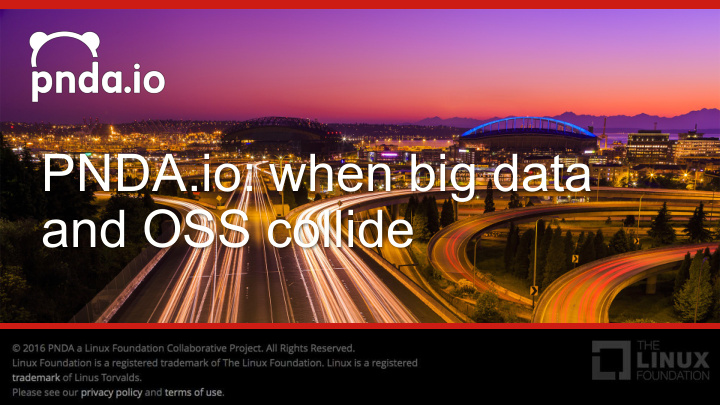



PNDA.io: when big data and OSS collide
[Build Slide] Simplified OSS / BSS Stack Bills and Order Customer Reports Order Billing and BSS Mgmt Reporting OSS analytics is responsible for Orchestration is responsible collecting data from the for service provisioning and infrastructure, monitoring and pushes state to the Provisioning Monitoring OSS OSS Analytics Orchestration analysis & Activation and analysis infrastructure The “F_APS” in FCAPS The “C” in FCAPS Network and Data Service Services
OSS Analytics is becoming a big data problem! Performance Big data analytics-based Small data analysis Engineering effort (time)
What changes? PMO FMO Orientation Single domain Cross domain Realisation Small data, tool driven Big data, data driven Data aggregation and Coupled Decoupled analysis Domain Data Schema Scheme-on-write Schema-on-read Analysis Prescriptive Prescriptive + Stochastic + ML Customisation Design time Run time
Today’s siloed analytics pipelines • Tight coupling of data aggregation/store/ analysis Spark Kafka Impala Logs • Multiple analytics Hbase Streaming pipelines implemented from open source components • Common design Metrics Streamsets MapR Query HDFS patterns ~75% of effort wasted / duplicated • Siloes limit the potential of big data analytics and Dashboard & Telemetry Kafka Storm NiFi Reporting lead to industry divergence Data sources Data aggregation Data store Data analysis Outputs
What is PNDA? PNDA brings together a number of open source technologies to provide a simple, scalable open big data analytics Platform for Network Data Analytics Linux Foundation Collaborative Project based on the Apache ecosystem
PNDA • Simple, scalable open data PNDA platform Visualisation Processing Query Applications and Exploration Real SQL Unmnged ODL Data • Provides a common set of Data Distribution App -time Query Exploration services for developing Logstash Unmnged analytics applications OLAP Metric App Stream Visualisation Cube • Accelerates the process of OpenBPM Search/ Event Batch developing big data analytics Visualisation Lucene PNDA Mnged App pmacct applications whilst significantly reducing the TCO PNDA File Time NoSQL Mnged App Store Series XR Telemetry • PNDA provides a platform for convergence of network data App Packaging Platform Services: Installation, Mgmt, PNDA and Mgmt Security, Data Privacy analytics Plugins PNDA PNDA Producer API Consumer API
PNDA • Horizontally scalable platform for analytics and data processing applications PNDA Visualisation Processing Query Applications and Exploration • Support for near-real-time stream Real SQL Unmnged ODL Data Data Distribution App processing and in-depth batch analysis -time Query Exploration on massive datasets Logstash Unmnged OLAP Metric App Stream Visualisation • PNDA decouples data aggregation from Cube data analysis OpenBPM Search/ Event Batch Visualisation Lucene PNDA • Consuming applications can be either Mnged App pmacct platform apps developed for PNDA or client apps integrated with PNDA PNDA File Time NoSQL Mnged App Store Series XR Telemetry • Client apps can use one of several structured query interfaces or consume App Packaging Platform Services: Installation, Mgmt, PNDA streams directly. and Mgmt Security, Data Privacy Plugins • Leverages best current practise in big PNDA PNDA data analytics Producer API Consumer API
Why PNDA? There are a bewildering number of big data technologies out there, so how do you decide what to use? We've evaluated and chosen the best tools, based on technical capability and community support. PNDA combines them to streamline the process of developing data processing applications.
Why PNDA? Innovation in the big data space is extremely rapid, but combining multiple technologies into an end-to-end solution can be extremely complex and time-consuming PNDA removes this complexity and allows you to focus on developing the analytics applications, not on developing the pipeline – significantly reducing the effort required and time-to- value
PNDA Software Components
Design time vs. runtime standard pico
BGP meets ’Big-data’
Building the application • Domain expertise • Data science specialist • Web ‘full stack’ specialist
Architecture • Needs BGP Speakers with BMP protocol support • BMP session established between BGP Speakers and OBMP
Architecture • Logstash required to perform ‘avro’ encoding of BMP data • BGP App runs as Batch job, running periodically
What does this give us? • OBMP gives us the ability to record the dynamics of the Internet • PNDA platform enables • ‘Raw’ event recording capability, with horizontal scaling (HDFS) • Run analysis over large data-sets with parallelism • Ask questions of the aggregate data about the Internet • Drill down analysis • Per-prefix • Per-AS • Per AS-Path
Potential • What can we do with large-scale collection of historical event information? • Event impact analysis – • Stability • Security • Misconfiguration • Application of ML/DL to data-set • Pattern-detection and network ‘weather forecasting’
Recommend
More recommend